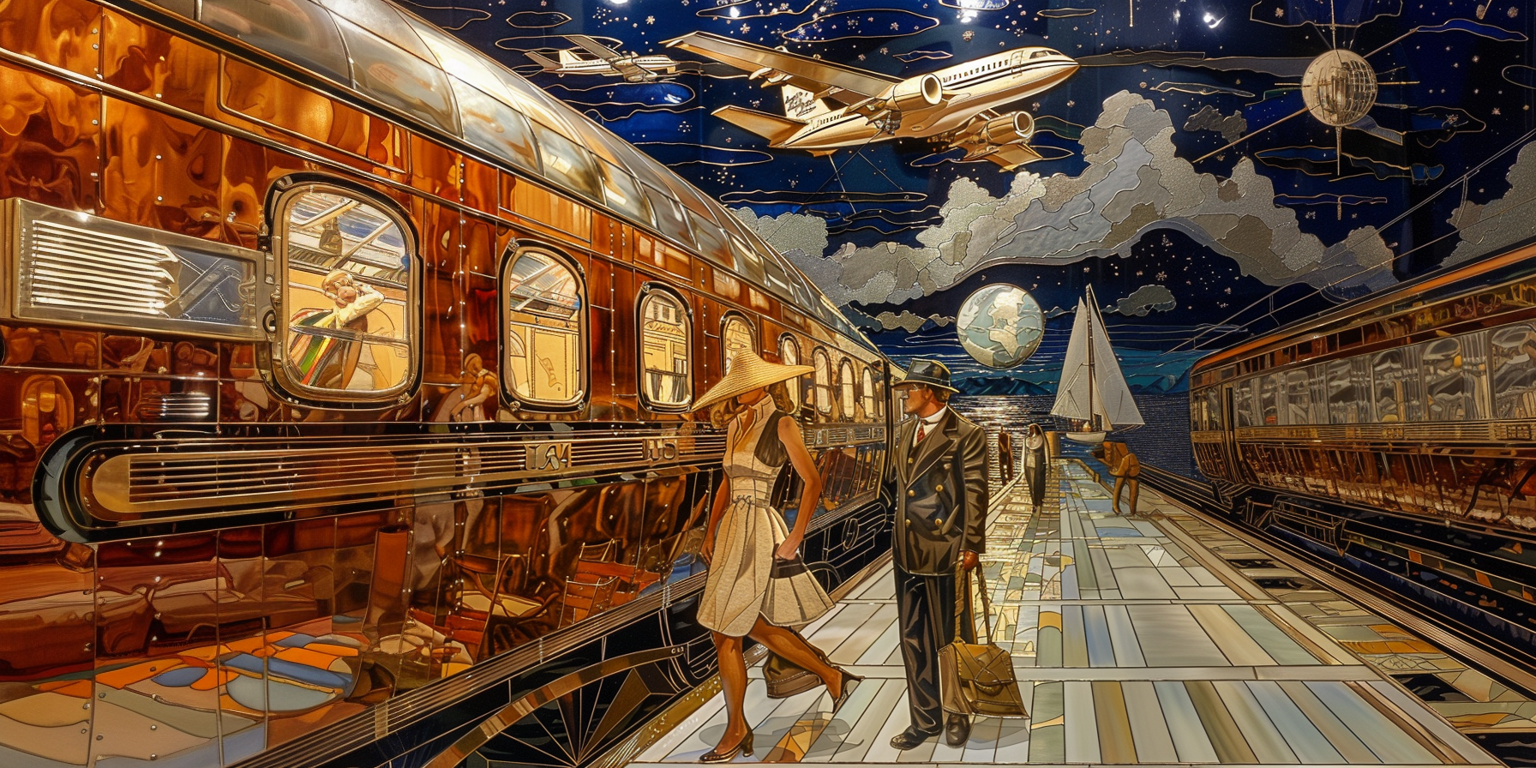“Our life is a constant journey, from birth to death. The landscape changes, people change, needs change, but the train goes on. Life is the train, not the station”.
Paulo Coelho
The beauty of travel never dries up, yet when we talk about it, it’s often the destination that comes first. But why not pay more attention to the journey itself? Make the most of the time before arriving at the hotel, or consider transportation to be an essential part of the journey. It’s a precept that seems to be increasingly adopted by the major hotel groups, who are now transforming the offer of “mobile” getaways into the luxurious experiences of tomorrow.
At the crossroads of all-inclusive hotels and atypical stays, more and more companies are seeking to diversify by developing luxury transportation. We’re witnessing the expansion of new offerings, such as prestige sailboats and yachts, but also the return of old concepts, such as “Orient Express”-style trains, or the integration of luxury transport into the offerings of iconic hotels.
Is top-of-the-range travel just a return to fashion? Luxury trains, like the Orient Express, remain a constant reference; yachts recall the golden age of cruising in the 1920s, when liners reigned supreme in the extravagance of crossings. Airplanes were once reserved for the elite, as were private cars, all designed to offer customers a high-end experience and lifestyle. In 2023, sales of yachts and private jets are up 11% on 2022, reaching 29 billion euros. (Bath)

If certain trends are resurfacing, it’s because the public is above all looking for authenticity in service. Travelers aspire to a unique and incomparable offer, where they are no longer simply staying like thousands of others, but rather participating in a special, timeless moment. Today, it’s the 360° luxury experience that prevails! The major groups have understood this and are basing their development on this fundamental economic trend, with luxury transport as a key segment. It’s against this backdrop that innovations and reintroductions in the high-end transport sector take on their full meaning.
La Voie des Rails
While the Venice Simplon Orient Express, one of the Belmond group’s jewels, has carried on the Orient Express legacy since 1982, the Accor group has also announced that it will launch its own train, the Orient Express La Dolce Vita, at the end of 2024. From one brand to another, the Orient Express is back in action!
And yet, historically, the Orient Express, though synonymous with luxury and extravagance, was primarily intended for rapid transport between Paris and Constantinople. Indeed, in 1883, the train was the fastest means of transport, and that’s how this offer developed.
Today, luxury trains are veritable hotels on rails, offering an all-inclusive service combining gastronomy, comfort and prestige. In addition to the famous “Orient Express” trains, which combine nostalgia and modernity, Belmond operates other locomotives such as the Belmond British Pullman in the UK, recalling the charm of the 1920s-1930s. This train offers excursions from London with gourmet offers and special events. The group also operates the Belmond Andean Explorer, the first luxury sleeper train in South America, linking Cuzco to Arequipa and offering a unique experience through the Andean landscape.
Similarly, other groups are developing prestigious travel offers around the world. For example, Rovos Rail, established in 1989, offers rail safaris in Africa, linking major destinations such as Cape Town, Durban and Victoria Falls. The Napa Valley Wine Train offers culinary itineraries through California’s Napa Valley wine region. In Asia, Kyushu’s Seven Stars Train offers a unique experience across Japan on the island of Kyushu, with exceptional service and decor inspired by local crafts. These initiatives show that the luxury rail travel sector is evolving with diversified and innovative offerings.


The Middle East is not to be outdone, with Saudi Arabia announcing the development of the “Dream Of Desert” project for 2025. The 40-cabin train will take passengers through the desert and the country’s spectacular scenery. The project aims to showcase the surrounding area to tourists and Saudi citizens alike, and to demonstrate Saudi Arabia’s influence. For many years now, the country has been seeking to establish itself as a preferred travel destination, and is investing heavily in this direction. “Dream of Desert” is therefore a new economic investment to enhance the peninsula’s portfolio of tourism offerings.
As a result, major groups are increasingly investing in luxury trains, which are becoming hotels on rails. They reinvent travel by seeking to capture the essence of the experience while integrating cutting-edge technologies and luxury services. These substantial investments respond to a growing demand for the travel experience and nostalgia for the era of the great odysseys. High-end continues to be a lucrative and diversifying market. Collaborations, notably with Groupe Arsenal (Le Dolce Vita and Dream of Desert) for interior design, illustrate how each luxury train integrates its own identity. While Accor’s Orient Express La Dolce Vita promises glamorous immersion in a refined setting, highlighting the art of living à la française, the Saudi “Dream Of the Desert” plays the soft power and cultural influence card, with an oriental style and decorative elements evoking the vast expanses of the desert.


In addition to collaborations for the complete creation of luxury trains, there are also specific partnerships for the decoration of carriages and the creation of gourmet menus, offering a unique identity to the different trains. For example, famous director Wes Anderson has redecorated a Belmond British Pullman carriage, Cygnus, with a nostalgic and elegant Art Deco design. Jean Imbert, appointed chef of the legendary Venice Simplon-Orient-Express in 2022, reinterprets the menus with a modern touch while respecting the train’s culinary heritage. Japanese artist Yoshitaka Amano contributed to the interior design of Train Suite Shiki-shima, adding a unique artistic and cultural touch. Artist and decorator Sarah Heller designed the interiors of the Rovos Rail carriages in South Africa, combining luxury and colonial style. These differences underline each group’s ability to offer a unique experience, while sharing an exceptional level of luxury and comfort.
The Big Blue
In parallel with these rail investments, the luxury cruise market is also experiencing significant growth, with both sailboats and yachts expected to reach 4 billion euros in 2023, more than double the figure for 2022 (Bain). Offers aimed at a privileged audience are growing all the time. Unlike the huge liners that can accommodate over 5,000 people, these solutions are more intimate, with fewer than 200 passengers on board. The aim is to attract the public by focusing on exceptional destinations as much as on the rarity of the product. High prices and top-quality service underline the fact that only the luckiest can get on board.
Companies such as The Four Seasons Yachts, The Ritz-Carlton Yacht Collection and Orient Express Silenseas (Accor) bear witness to the growing interest of major hotel groups in this new business opportunity, with increasingly extravagant projects. Each adopts the mantra: “Nothing like this on the market”. But how can this economic trend be profitable in the face of such fierce competition? How do you sell these cruises, which, while promoting an unrivalled luxury experience, are also very expensive?


It’s all down to the uniqueness of the concept! Indeed, 61% of the most affluent people like to get off the beaten track when they’re on vacation (YouGov). The companies offer constantly reinvented cruises, with evolving itineraries and shows. Each moment is unique and often irreplaceable. The companies sell not only luxury accommodation and top-quality service, but also adventure, which helps fill the ships.
Hervé Humler, President and Chief Operating Officer of The Ritz-Carlton Hotel Company, said, “This unique combination of yachting and cruising will usher in a luxurious new way of traveling for our guests, who are looking to discover the world in a relaxed, elegant and comfortable atmosphere, with high-end personalized service.” (Hospitality-on)
These floating establishments perfectly combine a luxurious lifestyle with the freedom of a mobile vacation, and offer privileged access to the world’s most beautiful ports. The smaller size of the ships, more than a choice dictated by scarcity for luxury, is also the promise of access to many villages usually inaccessible to larger ships. These new cruises symbolize the perfect alliance between the nostalgia and quality of the voyages of yesteryear and the safety of today’s boats.
At the same time, modern innovation is also reflected in a more sustainable approach. Although boats are often considered particularly polluting, major hotel groups are seeking to integrate an eco-responsible dimension into their projects. For example, Accor offers yachts powered by liquefied natural gas and wind energy, with three sails allowing 100% sailing under the right conditions. The Ritz-Carlton Yacht Collection, meanwhile, guarantees the sustainability of its wastewater treatment and drinking water production systems using clean technologies.

Luxury cruises thus represent an innovative facet of high-end tourism, combining intimacy, exclusivity and a constantly renewed travel experience. It’s not about transporting passengers from point A to point B; it’s about offering a complete experience in sumptuous surroundings.
Le 7eme Ciel
The 5* mobile hotel industry is also taking to the skies, with private jets also taking part in the revival of exceptional transport. Indeed, 10% of the most affluent are willing to pay more for a jet/helicopter experience (YouGov). Although this mode of transport is already present in the private sphere, hotels are increasingly looking to offer packages in partnership with private airlines. This trend is driven in part by a growing demand from luxury travelers for seamless staycation experiences. By joining forces, the two entities create emblematic, personalized travel itineraries. Every step, from take-off to landing, is carefully orchestrated, giving hotels and private airlines the opportunity to attract a wealthy clientele willing to pay for prestige, value-added services.
In 2014, Four Seasons announced the launch of a Boeing 757 equipped exclusively for 52 first-class passengers, offering a three-week round-the-world trip for $119,000 per passenger. In 2017, Four Seasons Hotels and Resorts teamed up with NetJets to offer travel itineraries in the form of three customized routes. These routes take travellers to dream destinations, guaranteeing a unique adventure. Four Seasons also offers the Four Seasons Private Jet, a private jet with 48 Italian leather seats, social areas, gourmet cuisine and dedicated staff, offering exclusive itineraries such as “African Wonders” and “Timeless Encounters”.

Similarly, Fairmont also offers private aviation services to take guests to hard-to-reach places. In addition to enhancing the hotels’ brand image, they increase customer satisfaction by offering an elegant and practical transport solution. In this way, the integration of exclusive aviation represents real added value for hotel establishments, enhancing their offer and creating solid relationships with airlines.
In conclusion, all these rethought transports, experiences and timeless journeys represent, above all, the return of exploration to the forefront of travel: a return to adventures that allow us to be in several places in the same journey. Major groups have understood this and see it as a significant business opportunity, while also contributing to the prestige of their brand. Wealthy travelers value the experience. Offering a special itinerary while retaining the quality of the finest palaces is the perfect alliance, giving customers the opportunity of an exceptional trip and enabling companies to charge ever higher prices.
Aboard these liners, planes and locomotives, nostalgic Mauretania passengers, Orient Express afficionados and modern jet-setters create memorable souvenirs and prove Paulo Coehlo right once again: more than the destination, it’s the journey that counts.




